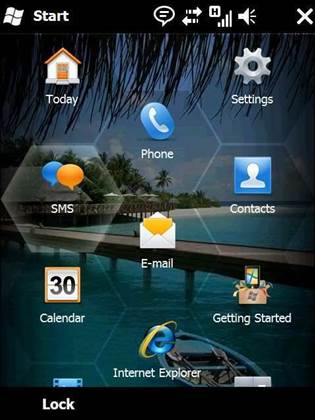Windows Mobile 6.5 features an improved user interface.

"Its time to take the full Windows experience to the phone," announced Microsoft CEO Steve Ballmer, delivering "an experience you would expect from a larger screen device."
Microsoft is encouraging partners to start calling any Smartphone using Windows Mobile 6.5 a "Windows Phone".
Devices featuring Windows Mobile 6.5 are expected to ship commercially by Q4 of the 2009 calendar year.
A new UI
In designing its new mobile operating system, Microsoft has made some clear choices about what experience should come standard with a Windows Phone and what experiences are left for carriers and users to customise.
Microsoft has set strict conditions on OEM partners and developers to ensure a seamless user experience for Windows Mobile users no matter what device they use.
The 'Start' icon, for example, is now compulsory.
"In the past, the Start icon may not have always been there on a Windows Mobile device, it varied from manufacturer to manufacturer," explained Natasha Kwan, general manager of Microsoft Communications, Asia Pacific.
"On Windows Mobile 6.5, the Start icon is standard - we have to make sure any given application doesn't compromise our look and feel," Kwan said.
"You can still customise, but consumers shouldn't have to re-learn new things with every Windows device. They should get much the same experience every time."
Windows Mobile 6.5 features a home screen with a customisable list of applications that can be opened via touch gestures.
Users can, for example, set up immediate one-touch access to their favourite songs from their music library, their latest mail messages or their favourite social networking applications.
Pressing the 'Start' button, meanwhile, arranges all available applications in a hexagonical 'honeycomb' pattern.
Microsoft has also optimised what personal information is visible when the phone is locked- displaying the time, the user's next appointment in their calendar, and notifications as to what calls, SMS, instant messages and e-mails they have missed since they were last using the device.
The new release comes with Internet Explorer 6 and full flash support, offering what Microsoft terms a 'PC quality browsing' experience.
IE6 on Windows Mobile 6.5 displays the entire web page in its full fidelity, employing new pan and zoom gestures for users to drill down on the content they wish to view.
Windows Mobile 6.5 phones will also feature new touch and gesture technology, developed in-house at Microsoft.
Users, for example, might drag their finger horizontally across the screen to flick between messages. An application icon slides to the left or right to execute, while holding the icon down saves the application to the home page.
Microsoft executives familiar with the technology made the navigation appear very fluid during the press conference, but iTNews found the interface clumsy and counter-intuitive upon our first look - it will take some effort for new users to hone their skills to use these shortcuts.
Kwan says there are still 'obvious enhancements' required before the final, stable code of Windows Mobile 6.5 is shipped to manufacturers. She is nonetheless confident that devices will ship by the close of 2009.
A Windows mobile app store
A key differentiator for Windows Mobile 6.5 is the way it leverages the assets Microsoft has already invested in on Windows PC's and the Web.
Microsoft will include in 6.5 its first attempt at an app store for Windows Mobile devices - the awkwardly titled Windows Marketplace for Mobile; as well as My Phone, a free back-up service for Windows Mobile devices integrated with the user ID of Windows Live.
The Marketplace will be a one-stop shop for users to browse, purchase and install applications to their Windows Mobile device.
Andy Lees, senior vice president of Microsoft's mobile communications business said the marketplace is an alternative option to loading apps from the web or installing them manually.
Developers will have to go through a certification process to ensure compatibility with Windows Mobile 6.5 before their applications can be listed in the store.
Commercial terms were not disclosed.
Incidentally, mobile handset manufacturer Nokia also released its first app store, Ovi, earlier in the morning.
My Phone
My Phone, meanwhile, is a Web service that backs up any user-generated information on the phone to the Internet or PC.
Each user will be allocated 200MB of online storage to back-up their contacts, photos, music and videos and calendar appointments. This data can subsequently be restored using a Windows Live ID.
My Phone will be available on all Windows 6.5 devices and via a downloadable client for older phones operating on Windows 6.1.
Lees said some 12 million mobile phones were lost in the United States last year. Most users lose whatever data was loaded on the device.
Kwan concedes that pre-existing backup solutions for Windows phones are already available via third party developers, but "not in the scale" of My Phone.
"It's the retrieval that is most important - you simply connect, type in your Windows Live ID and download your data," she said.
Scale
Microsoft's launch featured endorsements from a huge ecosystem of partners - with handsets demonstrated by HTC and LG and messages of support from Verizon, Sprint and Telstra's Sol Trujillo.
Microsoft claims to have 50 phone manufacturers, 160 carriers and 500,000 software developers in its Windows Mobile ecosystem.
Brett Winterford reports live and exclusively from Mobile World Congress for iTnews.



_(20).jpg&h=140&w=231&c=1&s=0)
_(22).jpg&h=140&w=231&c=1&s=0)
.png&h=140&w=231&c=1&s=0)



_(26).jpg&w=100&c=1&s=0)

 iTnews Executive Retreat - Security Leaders Edition
iTnews Executive Retreat - Security Leaders Edition












_(1).jpg&h=140&w=231&c=1&s=0)



